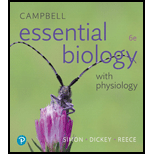
a.
To determine: Which part of the plant is the tomato.
Concept introduction: The plant body consists of a root system and shoots system. The roots are formed under the soil, and the upper part forms a shoot that gives rise to a leaf, stem, flower, and fruit. The root anchors the plant to the soil and transports minerals and water and stores food. The leaves are the primary sites of photosynthesis and help in exchange of gases with the atmosphere and to dissipate the heat.
b.
To determine: Which part of the plant is the apple.
Concept introduction: The plant body consists of a root system and shoot system. The roots are formed under the soil, and the upper part forms a shoot that gives rise to a leaf, stem, flower, and fruit. The root anchors the plant to the soil and transports minerals and water and stores food. The leaves are the primary sites of photosynthesis and help in exchange of gases with the atmosphere and to dissipate the heat.
c.
To determine: Which part of the plant is the spinach.
Concept introduction: The plant body consists of a root system and shoot system. The roots are formed under the soil, and the upper part forms a shoot that gives rise to a leaf, stem, flower, and fruit. The root anchors the plant to the soil and transports minerals and water and stores food. The leaves are the primary sites of photosynthesis and help in exchange of gases with the atmosphere and to dissipate the heat.
d.
To determine: Which part of the plant is the sweet potato.
Concept introduction: The plant body consists of a root system and shoot system. The roots are formed under the soil, and the upper part forms a shoot that gives rise to a leaf, stem, flower, and fruit. The root anchors the plant to the soil and transports minerals and water and stores food. The leaves are the primary sites of photosynthesis and help in exchange of gases with the atmosphere and to dissipate the heat.
e.
To determine: Which part of the plant is the black bean.
Concept introduction: The plant body consists of a root system and shoot system. The roots are formed under the soil, and the upper part forms a shoot that gives rise to a leaf, stem, flower, and fruit. The root anchors the plant to the soil and transports minerals and water and stores food. The leaves are the primary sites of photosynthesis and help in exchange of gases with the atmosphere and to dissipate the heat.
Want to see the full answer?
Check out a sample textbook solution
Chapter 28 Solutions
Campbell Essential Biology with Physiology (6th Edition)
- 22. Which of the following mutant proteins is expected to have a dominant negative effect when over- expressed in normal cells? a. mutant PI3-kinase that lacks the SH2 domain but retains the kinase function b. mutant Grb2 protein that cannot bind to RTK c. mutant RTK that lacks the extracellular domain d. mutant PDK that has the PH domain but lost the kinase function e. all of the abovearrow_forwardWhat is the label ?arrow_forwardCan you described the image? Can you explain the question as well their answer and how to get to an answer to an problem like this?arrow_forward
- Describe the principle of homeostasis.arrow_forwardExplain how the hormones of the glands listed below travel around the body to target organs and tissues : Pituitary gland Hypothalamus Thyroid Parathyroid Adrenal Pineal Pancreas(islets of langerhans) Gonads (testes and ovaries) Placentaarrow_forwardWhat are the functions of the hormones produced in the glands listed below: Pituitary gland Hypothalamus Thyroid Parathyroid Adrenal Pineal Pancreas(islets of langerhans) Gonads (testes and ovaries) Placentaarrow_forward
 Human Anatomy & Physiology (11th Edition)BiologyISBN:9780134580999Author:Elaine N. Marieb, Katja N. HoehnPublisher:PEARSON
Human Anatomy & Physiology (11th Edition)BiologyISBN:9780134580999Author:Elaine N. Marieb, Katja N. HoehnPublisher:PEARSON Biology 2eBiologyISBN:9781947172517Author:Matthew Douglas, Jung Choi, Mary Ann ClarkPublisher:OpenStax
Biology 2eBiologyISBN:9781947172517Author:Matthew Douglas, Jung Choi, Mary Ann ClarkPublisher:OpenStax Anatomy & PhysiologyBiologyISBN:9781259398629Author:McKinley, Michael P., O'loughlin, Valerie Dean, Bidle, Theresa StouterPublisher:Mcgraw Hill Education,
Anatomy & PhysiologyBiologyISBN:9781259398629Author:McKinley, Michael P., O'loughlin, Valerie Dean, Bidle, Theresa StouterPublisher:Mcgraw Hill Education, Molecular Biology of the Cell (Sixth Edition)BiologyISBN:9780815344322Author:Bruce Alberts, Alexander D. Johnson, Julian Lewis, David Morgan, Martin Raff, Keith Roberts, Peter WalterPublisher:W. W. Norton & Company
Molecular Biology of the Cell (Sixth Edition)BiologyISBN:9780815344322Author:Bruce Alberts, Alexander D. Johnson, Julian Lewis, David Morgan, Martin Raff, Keith Roberts, Peter WalterPublisher:W. W. Norton & Company Laboratory Manual For Human Anatomy & PhysiologyBiologyISBN:9781260159363Author:Martin, Terry R., Prentice-craver, CynthiaPublisher:McGraw-Hill Publishing Co.
Laboratory Manual For Human Anatomy & PhysiologyBiologyISBN:9781260159363Author:Martin, Terry R., Prentice-craver, CynthiaPublisher:McGraw-Hill Publishing Co. Inquiry Into Life (16th Edition)BiologyISBN:9781260231700Author:Sylvia S. Mader, Michael WindelspechtPublisher:McGraw Hill Education
Inquiry Into Life (16th Edition)BiologyISBN:9781260231700Author:Sylvia S. Mader, Michael WindelspechtPublisher:McGraw Hill Education





